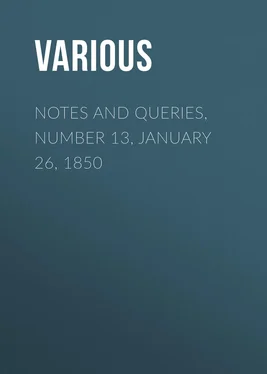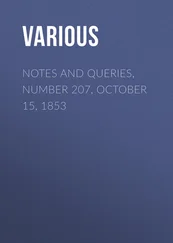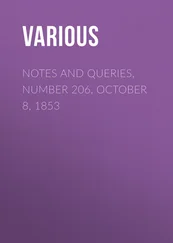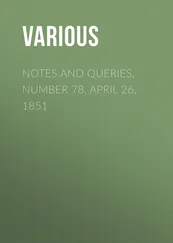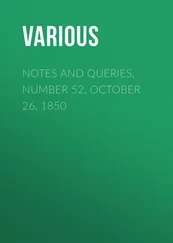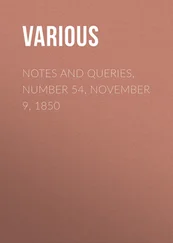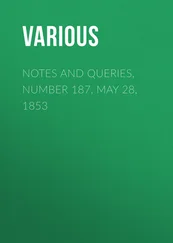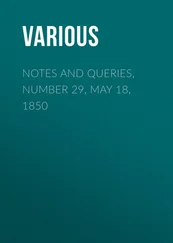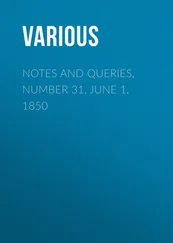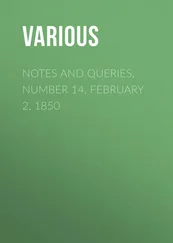Various - Notes and Queries, Number 13, January 26, 1850
Здесь есть возможность читать онлайн «Various - Notes and Queries, Number 13, January 26, 1850» — ознакомительный отрывок электронной книги совершенно бесплатно, а после прочтения отрывка купить полную версию. В некоторых случаях можно слушать аудио, скачать через торрент в формате fb2 и присутствует краткое содержание. Жанр: foreign_antique, periodic, foreign_edu, на английском языке. Описание произведения, (предисловие) а так же отзывы посетителей доступны на портале библиотеки ЛибКат.
- Название:Notes and Queries, Number 13, January 26, 1850
- Автор:
- Жанр:
- Год:неизвестен
- ISBN:нет данных
- Рейтинг книги:4 / 5. Голосов: 1
-
Избранное:Добавить в избранное
- Отзывы:
-
Ваша оценка:
- 80
- 1
- 2
- 3
- 4
- 5
Notes and Queries, Number 13, January 26, 1850: краткое содержание, описание и аннотация
Предлагаем к чтению аннотацию, описание, краткое содержание или предисловие (зависит от того, что написал сам автор книги «Notes and Queries, Number 13, January 26, 1850»). Если вы не нашли необходимую информацию о книге — напишите в комментариях, мы постараемся отыскать её.
Notes and Queries, Number 13, January 26, 1850 — читать онлайн ознакомительный отрывок
Ниже представлен текст книги, разбитый по страницам. Система сохранения места последней прочитанной страницы, позволяет с удобством читать онлайн бесплатно книгу «Notes and Queries, Number 13, January 26, 1850», без необходимости каждый раз заново искать на чём Вы остановились. Поставьте закладку, и сможете в любой момент перейти на страницу, на которой закончили чтение.
Интервал:
Закладка:
With regard to its provincial English name, Barnabee , the correct interpretation might be found in Barn-bie , the burning, or fire-fly, a compound word of Low-Dutch origin.
We have a small black beetle, common enough in summer, called PÂN, nearly hemispherical: you must recollect that the â is as broad as you can afford to make it, and the final n is nasal. Children never forgot, whenever they caught this beetle, to place it in the palm of their left hand, when it was invoked as follows:—
"PÂN, PÂN, mourtre mé ten sang,
Et j'te doûrai de bouan vin blianc!"
which means, being interpreted,
"PÂN, PÂN, show me thy blood,
And I will give thee good white wine!"
As he uttered the charm, the juvenile pontiff spat on poor Thammuz, till a torrent of blood, or what seemed such, "ran purple" over the urchin's fingers.
Paul-Ernest Jablonski's numerous readers need not be told that the said beetle is an Egyptian emblem of the everlasting and universal soul, and that its temple is the equinoctial circle, the upper hemisphere. 1 1 Pantheon Ægypt. tom. 1. p. 63.
As a solar emblem, it offers an instructive object of inquiry to the judicious gleaners of the old world's fascinating nursery traditions. Sicilian Diodorus tells us that the earth's lover, Attis (or Adonis), after his resuscitation, acquired the divine title of PAPAN. 2 2 Diodor. Sic. Biblioth. p. 134.
To hazard the inoffensive query, why one of our commonest great beetles is still allowed to figure under so distinguished a name, will therefore reflect no discredit upon a cautious student of nearly threescore years. The very Welsh talked, in William Baxter's time, of "Heaven, as bugarth PAPAN," the sun's ox-stall or resting-place; and here you likewise find his beetle-majesty, in a Low-Norman collection of insular rhymes:—
"Sus l'bord piâsottaient, côte-à-côte,
Les équerbots et leas PAPANS,
Et ratte et rat laissaient leux crotte
Sus les vieilles casses et même dedans." 3 3 Rimes Guernesiaises, p. 4.
By the help of Horapollo, Chiflet's gnostic gems, and other repertories of the same class, one might, peradventure, make a tolerable case in favour of the mythological identity of the legend of Ladybird—that is, the sun-chafer , or barn-bie , the fire-fly , "whose house is burnt, and whose bairns are ten," of course the first ten days of the Egyptian year 4 4 Or the dog-days. Each sign has three Decans, or captains of ten.
—with the mystical stories of the said black or dark blue lords of radiance, Pân and Papân .
The Egyptians revere the beetle as a living and breathing image of the sun, quoth Porphyry. 5 5 Porphyr. apud Euseb. Præp. iii. 4.
That will account for this restless delver's extraordinary talismanic renown. I think the lady-bird is "the speckled beetle" which was flung in hot water to avert storms. 6 6 Plin. Nat. Hist. lib. 37. cap. 10.
Pignorius gives us the figure of the beetle, crowned with the sun, and encircled with the serpent of eternity; while another, an onyx in the collection of Abraham Gorlæus, threatens to gnaw at a thunderbolt. 7 7 Chiflet, p. 133. A genuine cockroach , and a formidable one. I think the English word of Spanish origin.
Reuven's book on the Egyptian Museum, which I have not seen, notices an invocation to "the winged beetle, the monarch ([Greek: tyrannos]) of mid-heaven," concluding with a devout wish that some poor creature "may be dashed to pieces."
Can any of your readers inform me what is meant by "the blood of the Phuôn ?"
Yours truly,
?St. Martin's, Guernsey, Jan. 9. 1850.
EXTRACTS FROM CHURCHWARDENS' ACCOUNTS OF ST. MARGARET'S, WESTMINSTER—WEIGHT OF BELLS IN ANCIENT TIMES—HISTORY OF A ROOD-LOFT
I send you a few Notes, collected out of the Churchwardens' Accounts of St. Margaret's, Westminster.
1stly. Some regarding the weight of bells in ancient days:—
"1526. The first bell weith ccccc lb.
The second bell weith ccccccxxj lb.
The third bell weith ixCvj lb.
The fourthe bell weith M.x lb.
The fyfthe belonging to our grete Lady
Bretherhed MvjCxiiij lb.
The sume of all the weight MMMMVIIC Li lb.
"1592. The broken Tennor waied xvjCxxj lb.
The new tennor ys. xiijC di
The greatest bell ys xxjC and di at lvjs. the C.
The iiij bell ys xvijC and di and xiiij lb.
The xiiij bell taken awaie was xiijC di.
The ij bell carried awaie was viijCiij qters.
The new bell viijC di.
Som totall of the bells, yron, tymber, and
workmanshipp lxxvl. vs. vd."
This appears to have been a sorry bargain, for soon after occur sad complaints of these bells, "very falsly and deceytfully made by Valentyne Trever." Perhaps your correspondent "CEPHAS" may explain the following entry:—
"1846. Item, paid for makying of a newe clapper to
Judas bell xd."
2ndly. Some entries, which make up a little history of a rood-loft:—
"1460. Item, sol' pro le skoryng de la belles sup' le
Rode lofte iiijd.
"1480. Item, paide for a doore in the rode lofte to
save and kepe the people from the Orgayns
xijd.
Item, paide to a carpynter for makyng of the
Crucyfix and the beme He standeth upon xls.
Item, paide for kervying of Mary and John
and the makyng newe xxxiij s . iiij d .
Item, for gilding of the same Mary and John
and the Crosse and iiij'or Evangelysts
vj l . vj s . viij d .
"1530. Item, payd to a labourer for helpying up the
Roode Loft into the stepull viij d .
"1534. Payd for a present for Mr. Alford and Mr.
Herytage for ther good wyll for tymber for
the newe Rode lofte ij s . ij d ."
The fickle tyrant Henry VIII. dies; a more consistent reign happily ensues.
"1548. Item, for the takying downe of the Roode, the
Tabernacle, and the Images iij s . vj d .
Also payd to Thomas Stokedale for xxxv ells
of clothe for the frunte of the Rode Lofte
whereas the x Commandements be wrytten,
price of the ell vj d . xxiij s . iiij d .
Also payd to hym that dyd wryght the said
x Commaundements and for ther drynking
lxvj s . ix d ."
Queen Mary succeeds the boy-king Edward VI., and restores the Ritual of her Church.
"1566. Item, payed for the Roode, Mary and John x l .
"1557. Item, for peyntyng the Roode, Mary and John
xl s .
For makyng xvij candilsticks for the roode-light
xj s . iiij d ."
Upon the accession of Queen Elizabeth once more, and this time for ever, the rood was destroyed, and the loft, though "reformed," did not long survive it.
"1559. Payde to John Rialle for his iij dayse work
to take downe the Roode, Mary and John
ij s . viij d .
For clevying and sawyng of the Roode, Mary
and John xij d .
"1560. Rec'd for the beame the Roode stood on, for
boords and other tymber parcell of the
Roode loft xlij s .
For the rest of the stuf belongying to the
Roode lofte ix l .
For the great clothe that hong before the
Rode xx s .
Item, paide to joyners and labowrers abowt
the takying downe and new reformyng of the
Roode Loft, &c. xxxvij l . x s . ij d .
Item, paide for boordes, glew, nayles, and
Читать дальшеИнтервал:
Закладка:
Похожие книги на «Notes and Queries, Number 13, January 26, 1850»
Представляем Вашему вниманию похожие книги на «Notes and Queries, Number 13, January 26, 1850» списком для выбора. Мы отобрали схожую по названию и смыслу литературу в надежде предоставить читателям больше вариантов отыскать новые, интересные, ещё непрочитанные произведения.
Обсуждение, отзывы о книге «Notes and Queries, Number 13, January 26, 1850» и просто собственные мнения читателей. Оставьте ваши комментарии, напишите, что Вы думаете о произведении, его смысле или главных героях. Укажите что конкретно понравилось, а что нет, и почему Вы так считаете.
